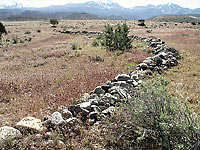May is Archaeology and Historic Preservation Month in Utah. In honor, I would like to share some history of the Civilian Conservation Corps (CCC) in the Moab area and highlight one of their great works in Spanish Valley.
 The CCC was a Depression-era public work relief program operated from 1933 to 1942 that provided jobs and training to young men aged 18-25 years. In Utah, 40 percent of enrollees were local boys and 60 percent were from out of state. Utah had a total of 116 camps, although only 30 to 40 were in operation at any given time; four of these were in the Moab area. The first was Warner Camp (F-20) established in the spring of 1933 near the Warner Ranger Station. This camp, managed by the Forest Service, completed a road along Brumley Ridge towards Geyser Pass. Later in 1933, the camp in Moab (PE-214) was built by present day Rotary Park and occupied somewhat continuously until 1941. This camp was managed by the Soil Conservation Service and completed several projects related to erosion and flood control. The next camp, Dalton Wells (DG-32), was built north of Moab in 1935. The Division of Grazing ran DG-32 and enrollees participated in range improvement projects. The CCC used this camp until 1941. Dalton Wells was utilized as a Japanese American internment camp briefly in 1943. The final camp in Grand County was the Arches Camp (NP-7). The National Park Service ran this camp between 1940 to 1942 and enrollees conducted various works in Arches National Park. The CCC was a Depression-era public work relief program operated from 1933 to 1942 that provided jobs and training to young men aged 18-25 years. In Utah, 40 percent of enrollees were local boys and 60 percent were from out of state. Utah had a total of 116 camps, although only 30 to 40 were in operation at any given time; four of these were in the Moab area. The first was Warner Camp (F-20) established in the spring of 1933 near the Warner Ranger Station. This camp, managed by the Forest Service, completed a road along Brumley Ridge towards Geyser Pass. Later in 1933, the camp in Moab (PE-214) was built by present day Rotary Park and occupied somewhat continuously until 1941. This camp was managed by the Soil Conservation Service and completed several projects related to erosion and flood control. The next camp, Dalton Wells (DG-32), was built north of Moab in 1935. The Division of Grazing ran DG-32 and enrollees participated in range improvement projects. The CCC used this camp until 1941. Dalton Wells was utilized as a Japanese American internment camp briefly in 1943. The final camp in Grand County was the Arches Camp (NP-7). The National Park Service ran this camp between 1940 to 1942 and enrollees conducted various works in Arches National Park.
 One incredible remnant of the CCC in the Moab area is the erosion control devices or “water spreaders” in lower Spanish Valley. There are over 100 of these water spreaders constructed by Camp PE-214 between 1933-1934. The water spreaders were built to stem the flow of water issuing from the western slopes of the La Sal Mountains, likely resulting from monsoon storms and spring melts, causing channel cutting and sheet wash in the valley; processes exacerbated by overgrazing and human modifications across the valley floor. These features were set throughout the valley, but mostly occur along the floodplain of Pack Creek. One incredible remnant of the CCC in the Moab area is the erosion control devices or “water spreaders” in lower Spanish Valley. There are over 100 of these water spreaders constructed by Camp PE-214 between 1933-1934. The water spreaders were built to stem the flow of water issuing from the western slopes of the La Sal Mountains, likely resulting from monsoon storms and spring melts, causing channel cutting and sheet wash in the valley; processes exacerbated by overgrazing and human modifications across the valley floor. These features were set throughout the valley, but mostly occur along the floodplain of Pack Creek.
These water spreaders consist of dry-laid diorite and sandstone cobbles collected from the valley floor and moved with the aid of heavy machinery or trucks into superficial rock alignments ranging from 15 to 1300 ft long and 2 to 14 ft wide. The water spreaders were built in the distinctive rustic architectural style of the CCC to ensure that features blended into the natural landscape. Roughly 1.2 million linear feet of water spreaders were constructed by the CCC in Utah, of which nearly 34,000 linear feet have been documented in lower Spanish Valley. These erosion control devices are a testament to the workmanship of the CCC as the features continue to be effective 86 years later.
To learn more about Archaeology and Historic Preservation Month, visit https://history.utah.gov
|
 The CCC was a Depression-era public work relief program operated from 1933 to 1942 that provided jobs and training to young men aged 18-25 years. In Utah, 40 percent of enrollees were local boys and 60 percent were from out of state. Utah had a total of 116 camps, although only 30 to 40 were in operation at any given time; four of these were in the Moab area. The first was Warner Camp (F-20) established in the spring of 1933 near the Warner Ranger Station. This camp, managed by the Forest Service, completed a road along Brumley Ridge towards Geyser Pass. Later in 1933, the camp in Moab (PE-214) was built by present day Rotary Park and occupied somewhat continuously until 1941. This camp was managed by the Soil Conservation Service and completed several projects related to erosion and flood control. The next camp, Dalton Wells (DG-32), was built north of Moab in 1935. The Division of Grazing ran DG-32 and enrollees participated in range improvement projects. The CCC used this camp until 1941. Dalton Wells was utilized as a Japanese American internment camp briefly in 1943. The final camp in Grand County was the Arches Camp (NP-7). The National Park Service ran this camp between 1940 to 1942 and enrollees conducted various works in Arches National Park.
The CCC was a Depression-era public work relief program operated from 1933 to 1942 that provided jobs and training to young men aged 18-25 years. In Utah, 40 percent of enrollees were local boys and 60 percent were from out of state. Utah had a total of 116 camps, although only 30 to 40 were in operation at any given time; four of these were in the Moab area. The first was Warner Camp (F-20) established in the spring of 1933 near the Warner Ranger Station. This camp, managed by the Forest Service, completed a road along Brumley Ridge towards Geyser Pass. Later in 1933, the camp in Moab (PE-214) was built by present day Rotary Park and occupied somewhat continuously until 1941. This camp was managed by the Soil Conservation Service and completed several projects related to erosion and flood control. The next camp, Dalton Wells (DG-32), was built north of Moab in 1935. The Division of Grazing ran DG-32 and enrollees participated in range improvement projects. The CCC used this camp until 1941. Dalton Wells was utilized as a Japanese American internment camp briefly in 1943. The final camp in Grand County was the Arches Camp (NP-7). The National Park Service ran this camp between 1940 to 1942 and enrollees conducted various works in Arches National Park. One incredible remnant of the CCC in the Moab area is the erosion control devices or “water spreaders” in lower Spanish Valley. There are over 100 of these water spreaders constructed by Camp PE-214 between 1933-1934. The water spreaders were built to stem the flow of water issuing from the western slopes of the La Sal Mountains, likely resulting from monsoon storms and spring melts, causing channel cutting and sheet wash in the valley; processes exacerbated by overgrazing and human modifications across the valley floor. These features were set throughout the valley, but mostly occur along the floodplain of Pack Creek.
One incredible remnant of the CCC in the Moab area is the erosion control devices or “water spreaders” in lower Spanish Valley. There are over 100 of these water spreaders constructed by Camp PE-214 between 1933-1934. The water spreaders were built to stem the flow of water issuing from the western slopes of the La Sal Mountains, likely resulting from monsoon storms and spring melts, causing channel cutting and sheet wash in the valley; processes exacerbated by overgrazing and human modifications across the valley floor. These features were set throughout the valley, but mostly occur along the floodplain of Pack Creek. 